Kos really hits that sweet spot between ancient history, wild nature, and those impossibly beautiful beaches that make you think, “Why don’t I live here?” After a few trips to this Dodecanese island, I’ve realized the trick is to blend your days—wander through 2,400-year-old healing sanctuaries, soak in volcanic hot springs, then just flop on the sand and let the Aegean do its thing.
I’ve stitched together an itinerary that’ll take you from the legendary grounds where Hippocrates taught medicine to the bubbling thermal springs of Therma Beach. There, hot water rises straight from the sea floor.
You’ll wind through mountain villages, poke around forgotten ruins, and eat your fill of Greek island food (trust me, you’ll want seconds).
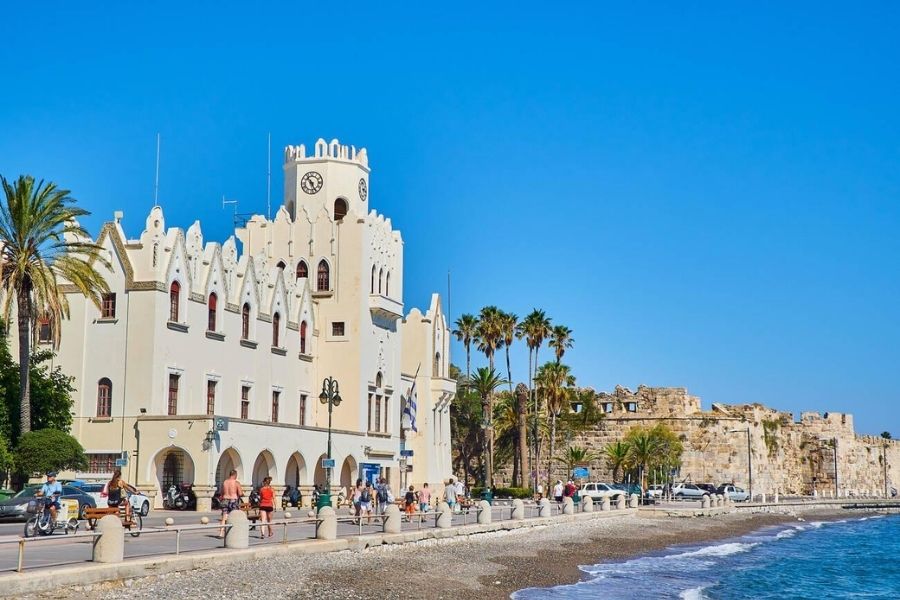
Whether you’ve got three days or a whole week, this guide helps you see Kos at your own pace. I’ll let you in on my favorite tavernas, the beaches worth lazing on (or paddleboarding across), and some sneaky day trips to volcanic islands most folks skip.
Discovering Kos: The Island’s Heritage, Setting, and Best Time to Visit
Kos sits out in the southeastern Aegean Sea, part of the historic Dodecanese chain. It’s one of those places where ancient healing traditions and modern Greek vibes collide in the best way.
The island’s location and wild backstory make it a smart base for mixing up culture and nature.
Where Kos Is Located in Greece
You’ll find Kos in the southeastern Aegean, almost close enough to Turkey to toss a stone—just 4 kilometers away. It’s one of the easternmost islands in the Dodecanese.
Rhodes is to the south, Patmos to the north, and that proximity to Turkey gives Kos a cultural twist I always notice.
Key Location Facts:
- 200 nautical miles southeast of Athens
- 4 kilometers from Turkey
- Rhodes is 85 nautical miles to the south
- Airport code: KGS (Kos International Airport)
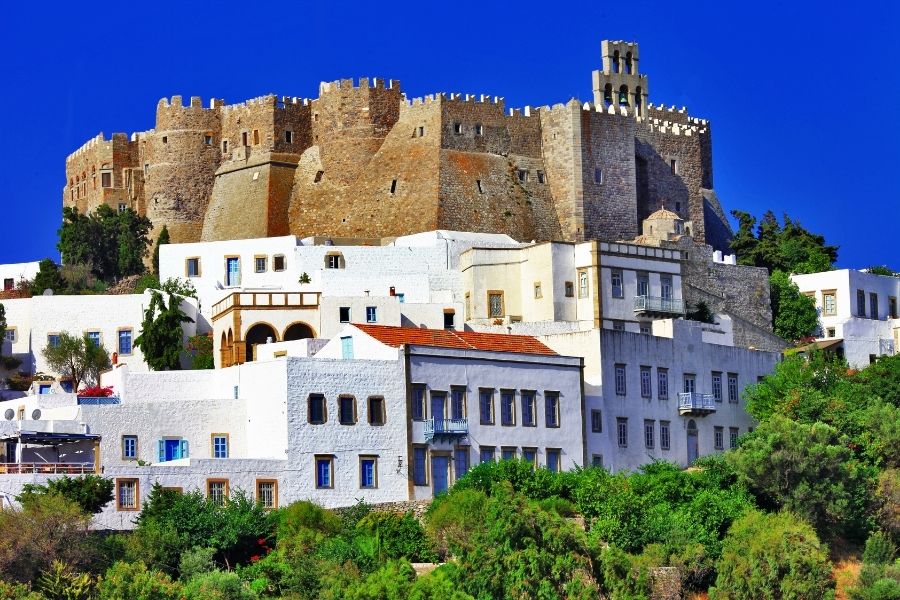
Ferries run from Piraeus in Athens (figure on 9-12 hours, so bring snacks). You can also hop between Kos and other Dodecanese islands pretty easily.
Overview of Kos and the Dodecanese Islands
The Dodecanese has 12 main islands, and Kos is the third biggest after Rhodes and Karpathos. Italian rule lasted until 1947, which explains the architecture you’ll spot around Kos town.
Kos covers 290 square kilometers and about 33,000 people call it home year-round. Tourism, farming, and fishing keep the island running.
Why Kos stands out in the Dodecanese:
- Ancient heritage: Birthplace of Hippocrates
- Healing springs: Three types of mineral springs—hot, warm, and cool
- Bike-friendly: Loads of bike paths, rare for Greek islands
- Endless beaches: Sandy stretches for days
Those Italian years (from 1912-1947) left their mark. Wide, tree-lined streets and a sense of order set Kos apart from the warren-like lanes on other islands.
Understanding Kos Town’s Role
Kos town is the capital and main port, with about half the island’s population living there. After a big earthquake in 1933, the town was rebuilt, which is why it feels so open and walkable now.
The Italian planners gave the town wide boulevards and big squares, so wandering on foot is a breeze. Eleftheria Square is the heart of it all, ringed by cafes and shops.
Major sights in Kos town:
- Nerantzia Castle (built in the 14th century)
- Ancient Agora ruins
- Hippocrates’ plane tree
- Archaeological Museum
- Medieval old quarter
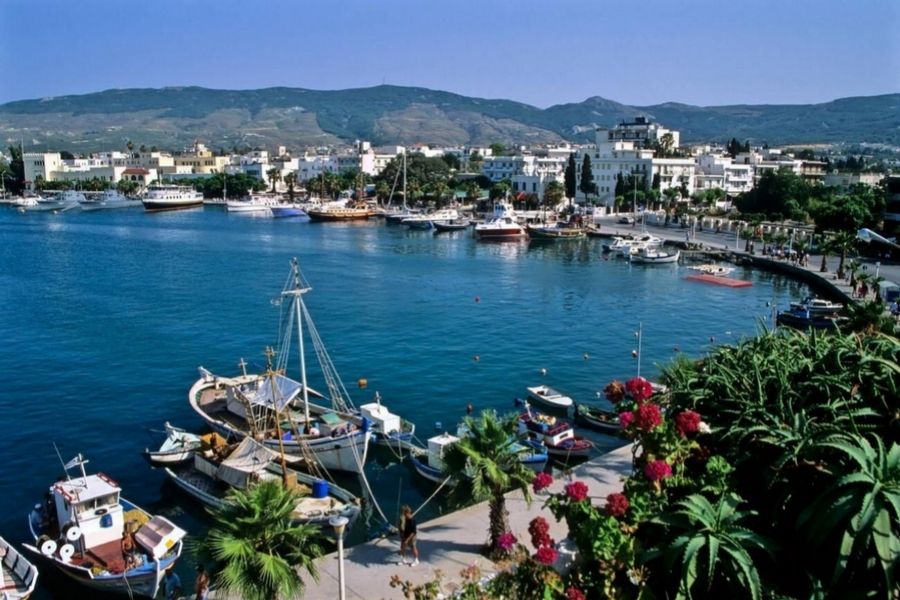
I usually base myself here for day trips. Buses run to the main beaches and ruins like the Asclepion.
You’ll spot modern shops and ancient ruins cheek by jowl in the center. It’s a trip to walk from Roman mosaics straight into a hip taverna.
Best Time to Visit for Weather and Experiences
Peak season (July-August) means hot days—up to 35°C (95°F)—and big crowds. If you love the buzz, go for it, but I prefer the edges of the season.
Shoulder months strike the best balance, in my opinion:
| Month | Temperature | Rainfall | Crowds | Swimming |
|---|---|---|---|---|
| May | 22-26°C | Low | Light | Good |
| June | 26-30°C | Very low | Moderate | Excellent |
| September | 24-28°C | Low | Moderate | Excellent |
| October | 20-24°C | Moderate | Light | Good |
Spring (April-May) brings wildflowers and perfect weather for hiking. The thermal springs are especially inviting when the air’s still cool.
Winter (December-February) hovers around 15°C, sometimes rainy. Most tourist spots shut down, but the quiet is kind of magical if you’re into culture and empty ruins.
The Meltemi winds pick up in July and August, cooling things down but sometimes messing with ferry schedules. September is my favorite for warm seas and gentler breezes.
Walking in the Footsteps of Hippocrates: Ancient Healing Sanctuaries and Historic Landmarks
Kos has some of the world’s most important medical history sites. The Asklepion, where Hippocrates taught, is just 4 km from town. Ancient ruins and that famous plane tree mark the start of Western medicine.
Exploring the Asklepion and Its Legacy
You’ll find the Asklepion of Kos on a hill 4 km southeast of town. This ancient healing sanctuary honored Asclepius, the Greek god of medicine.
Hippocrates practiced and taught here in the 5th century BC. He turned it into one of the world’s earliest medical schools.
The sanctuary sits on three terraces, each one a little higher up the hill. Patients moved up as they got healthier.
The Three Terraces:
- Lower terrace: Greek-style stoa, a fountain, and Roman baths from the 3rd century AD
- Middle terrace: The oldest bit, with the Temple of Apollo (seven columns have been restored) and the Ionic Temple of Asclepius
- Upper terrace: Doric Temple of Asclepius, with killer views over Kos town and the harbor
Back in the day, patients would sleep in the temple, hoping Asclepius would heal them through dreams.
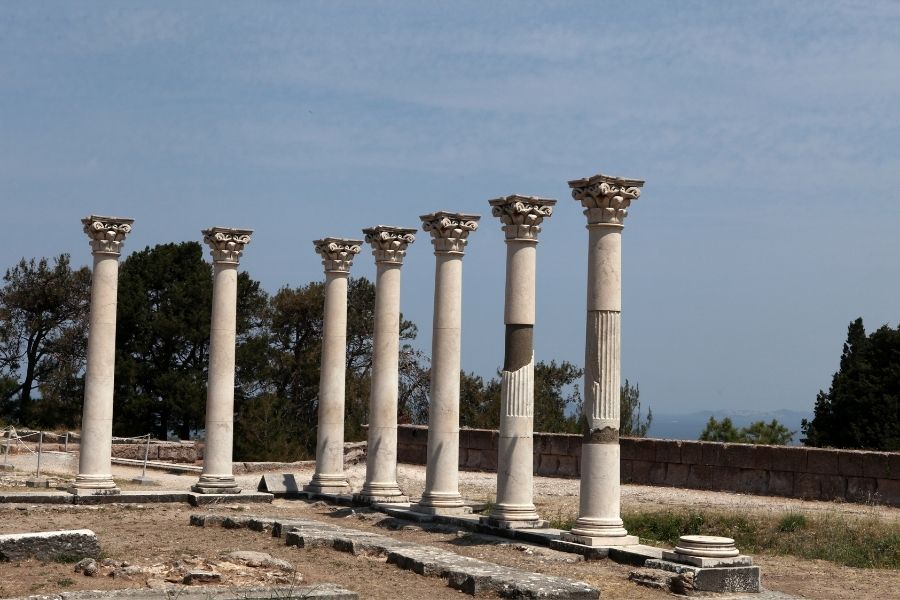
Hot springs bubble up nearby, and people used them for treatments. Even now, the place feels calm—there’s something about the air up there.
Ancient Agora and Archaeological Sites
The ancient agora sits right by Kos harbor. It used to be the island’s main marketplace and hangout.
A huge earthquake in 1933 revealed the ruins. That disaster exposed mosaics, temple bases, columns, old houses, and baths.
You can stroll through the ruins for free. Bright bougainvillea pops up between the stones, and you get a real sense of ancient daily life.
The agora links straight to the modern bar street. It’s a wild contrast—ancient stones on one side, nightlife on the other.
Artifacts from the site fill the Kos Archaeological Museum. You’ll see sculptures, medical vessels, and old surgical tools from the Asklepion era.
Tree of Hippocrates: Where Medicine Began
The Tree of Hippocrates stands in Platia Plantanou square, right in front of Neratzia Castle. This enormous plane tree is about 500 years old.
Locals say it’s descended from the tree where Hippocrates taught his students 2,400 years ago. The trunk is hollow now and propped up with metal scaffolding.
A statue of Hippocrates stands nearby, holding a staff with a snake—now the symbol of medicine.
The International Hippocrates Foundation and Museum is close. It’s got exhibits, a library, and educational programs all about the father of medicine.
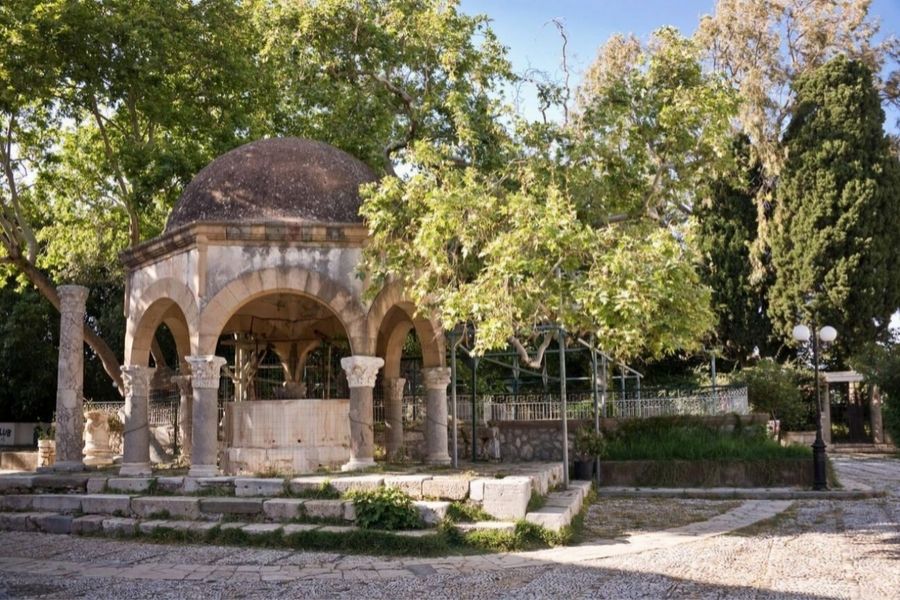
Standing here, I always feel a little awe. The square is peaceful, and it’s easy to picture ancient lessons happening beneath those branches.
Neratzia Castle and the Castle of the Knights
Neratzia Castle, or the Castle of the Knights, stands guard over Kos harbor. The Knights Hospitallers of Rhodes built it in the 14th century.
They used stones from the Asklepion and other ancient sites to build the walls. Recycling was apparently a thing even back then.
A stone bridge links the castle to the square with the Tree of Hippocrates. You can walk straight from medieval to ancient history in a few steps.
The castle acted as a defense against Ottoman attacks. Its thick walls and prime harbor spot made it a real stronghold.
You can climb the walls and towers for sweeping views. From up top, you see the ancient agora and the modern town laid out below.
The castle is a reminder that layer after layer of history stacks up here. Medieval knights, ancient Greeks, and today’s locals have all left their mark.
Soothing Body and Soul: Volcanic Hot Springs and Unique Nature Escapes
Kos has its own brand of natural healing, thanks to volcanic hot springs at Therma Beach and the dramatic volcanic landscape of nearby Nisyros Island.
The island’s geothermal activity creates wellness experiences you just don’t get everywhere—think seaside hot pools and craters you can hike.
Therma Hot Springs and Coastal Retreats
I stumbled on Therma Beach on Kos’s southern coast, where natural hot springs mix with the Aegean. The water gets up to 40-50°C, flowing into shallow pools right by the sea.
The springs are loaded with sulfur and other minerals. I found the best pools at low tide, when the seawater hasn’t cooled them down much.
Best times to visit:
- Early morning (7-9 AM) if you want peace and quiet
- Late afternoon (4-6 PM) for the sunset crowd
- September through May when the air is cooler

The springs bubble year-round, but in summer, the hot water can feel a bit much. Bring water shoes—the rocks are sharp and slippery.
Tavernas nearby serve up fresh seafood and classic Greek eats. The drive from Kos Town takes about 45 minutes along twisty coastal roads.
Visiting Volcanic Nisyros Island
Nisyros Island is just 16 kilometers from Kos and has one of Europe’s easiest-to-access volcanic craters. I hopped on the daily ferry from Kardamena, which runs from April to October.
Mandraki, the main port, greets you with whitewashed buildings and narrow alleys. Buses take you to the volcanic crater in about 20 minutes.
Ferry details:
- Leaves in the morning at 9:00 AM
- Heads back at 4:00 PM
- Takes 45 minutes each way
- Costs around €15-20 round trip
Down in the crater, you’ll see smaller craters with bubbling sulfur springs and steam vents. You can walk the main trail in about half an hour.
The volcanic soil here grows wild herbs and rare flowers you won’t find on other Dodecanese islands.
Exploring Kefalos and Off-the-Beaten-Path Natural Wonders
Kefalos, on the western peninsula, is a landscape-lover’s dream. I explored sea caves, hidden beaches, and old ruins scattered across volcanic hills.
Don’t miss these natural spots:
- Agios Stefanos Beach: Clear water and ancient basilica ruins
- Camel Rock: A rock shaped by wind and waves (it really does look like a camel)
- Paradise Beach: Big sand dunes and turquoise water
- Limnionas Beach: A secret cove you reach by dirt road
The volcanic past left behind strange rock shapes and mineral deposits. I found little pools where seawater warms up in the sun—perfect for a quick dip.
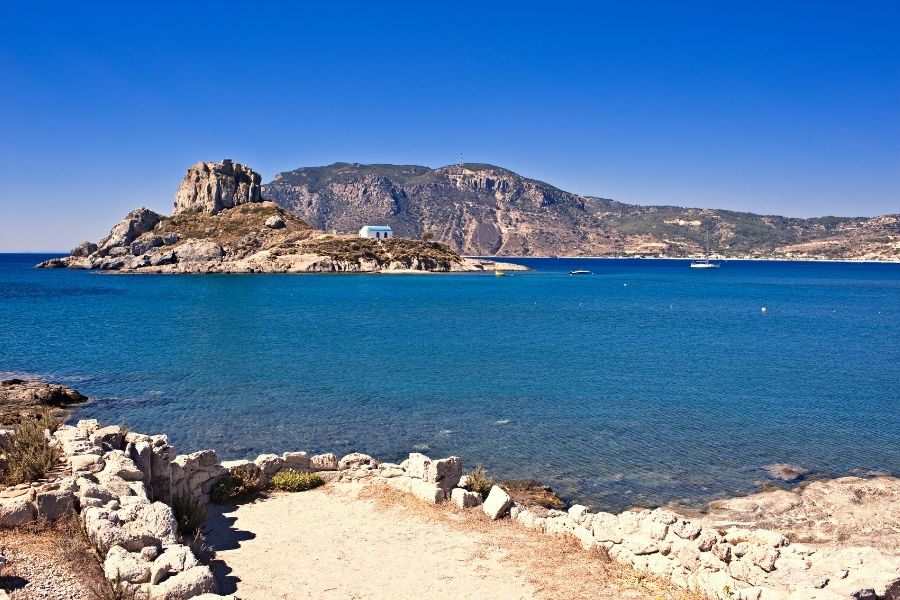
Wild oregano, thyme, and sage cover the hills. Local beekeepers make honey that tastes like the island itself.
Mountain biking trails connect the beaches, with views all the way to Turkey. I rented a bike in Kefalos village and followed the signs to some seriously quiet swimming spots.
Relaxing on Kos’ Best Beaches: From Lazy Days to Watersports
Kos is packed with beaches for every mood—think the shallow, clear waters of Tigaki for families, or the buzz of Paradise Beach if you want a little action. You’ll find hidden coves near Mastichari and lively beach bars in Kardamena.
Tigaki Beach: Family-Friendly Relaxation
Tigaki Beach is my top pick for families. It’s just 11 kilometers west of Kos Town and stretches out with soft sand and shallow, see-through water.
The beach is well set up, with sunbeds and umbrellas for rent. The gentle slope into the sea is great for little ones who want to splash around.
Why I love Tigaki:
- Soft white sand that’s easy on bare feet
- Calm, shallow water for safe swimming
- Quick access from most hotels
- Tavernas and cafes just steps away
Tigaki’s northern spot means there’s usually a breeze—perfect for keeping cool in the summer. Arrive early if you want the best spot, especially in July or August.
Paradise Beach and Fun in the Sun
Paradise Beach really does live up to its name. The water stays clear, and lush greenery wraps around the cove.
During the summer, the place buzzes with energy. You’ll find a vibrant crowd soaking up the sun.
I like how you can pick between organized sections with sunbeds or quieter, untouched stretches. It’s rare to find a beach that manages to please both types of beachgoers in one spot.
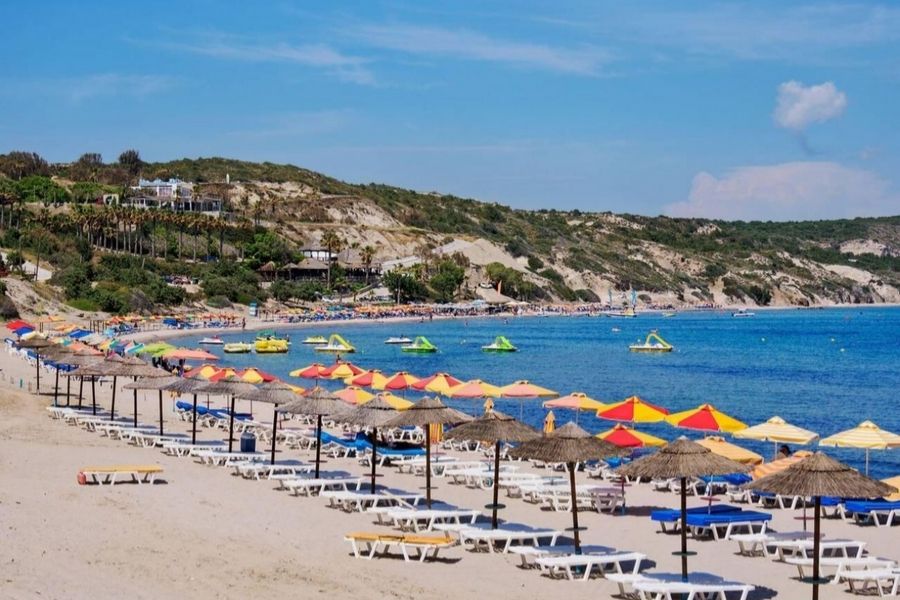
Paradise Beach highlights:
- A mix of lively, organized areas and peaceful, natural corners
- Nudism-friendly sections for those who want them
- Clean, inviting water for swimming
- Natural shade thanks to all that greenery
Since Paradise Beach sits about 30 kilometers from Kos Town, it never feels as packed as the beaches closer to town. Even with the summer crowds, I’ve noticed the water stays impressively clean.
Nos Beach, Mastichari, and Hidden Seaside Gems
Mastichari Beach has this exotic vibe—soft white sand and emerald water that practically begs you to jump in. Windsurfers especially love it, and you’ll spot a few watersports centers lining the shore.
It’s 27 kilometers southwest of Kos Town, so expect plenty of people, especially in peak season. If you’re after an active day at the beach, Mastichari delivers.
Mastichari Beach features:
- Top-notch windsurfing conditions
- Soft, bright sand underfoot
- Watersports rental spots for all levels
- Well-kept facilities when you need a break
If you wander near Kefalos, you’ll stumble on quieter coves—real hidden gems. The long sandy bay there frames the tiny Kastri islet, which makes for some seriously good photos.
Beach Bars and Coastal Entertainment
Kardamena Beach brings the party to Kos. The sand stretches out, the water sparkles, and there’s no shortage of things to do—diving clubs, watersports, you name it.
Younger crowds flock here for the lively beach bars. I’ve stayed out late more than once, enjoying the music and the energy that lasts well into the night.
Entertainment options include:
- Beach bars for cocktails and music
- Watersports rentals—think jet skis and parasailing
- Diving clubs if you want to explore underwater
- Restaurants with fresh-caught seafood
If you want something a bit closer to Kos Town, check out Lambi Beach. The Lambi Mylos area has beach bars right in front of an old windmill—definitely a spot with Greek character, especially after sunset.
Immersing in Island Life: Kos Town Exploration, Villages, and Day Trips
Kos strikes a great balance between lively town life, authentic villages, and easy island-hopping. It’s a solid base for day trips to mountain villages or ferry rides to other Dodecanese islands.
Strolling Through Kos Town’s Streets and Harbor
Kos Town charms visitors with a mix of ancient ruins and that unmistakable Greek island vibe. I usually start at the harbor—fishing boats and fancy yachts bobbing side by side.
Wide pedestrian streets make wandering easy. Cafes and shops line the way, and you can’t miss the Hippocrates Tree, a massive plane tree that’s seen over 2,000 years of history.

Key attractions include:
- Ancient Agora ruins scattered through town
- Castle of the Knights looking out over the harbor
- Archaeological Museum with local finds
- Eleftherias Square, perfect for evening people-watching
Sunset brings the harbor to life. Taverns serve up seafood, and street performers draw a crowd. I always recommend ducking into the side streets—you’ll find a slice of real Greek life away from the main drag.
Traditional Villages Like Zia and Local Culture
Zia village perches on Mount Dikeos, offering sunsets that make you stop and stare. Stone houses and family-run tavernas keep the place feeling traditional.
You’ll find handmade crafts and jars of local honey in the village shops. Textiles and ceramics, all made by local hands, fill the shelves. As evening falls, photographers gather for those famous sunsets.
Other notable villages:
- Pyli, with its medieval castle ruins
- Kardamena, for a mix of beach and village life
- Antimachia, right by the airport, with traditional architecture
Village festivals and religious celebrations bring out the best of local culture. I’ve watched Greek dancing and listened to live bouzouki music on summer nights. The tavernas here serve dishes made with ingredients straight from village gardens.
Day Trips to Nearby Islands: Rhodes, Symi, Leros, and More
If you’re itching to explore, the Dodecanese islands are just a ferry ride away. Boats connect Kos to several spots in one to three hours.
Rhodes tops the list for day trips. Its Medieval Old Town and the Palace of the Grand Master are steeped in history. Ferries run daily in summer, so it’s easy to plan.
Symi draws you in with its colorful neoclassical harbor. The island’s famous for natural sponges and hiking trails. You’ll get there in about two hours by ferry.
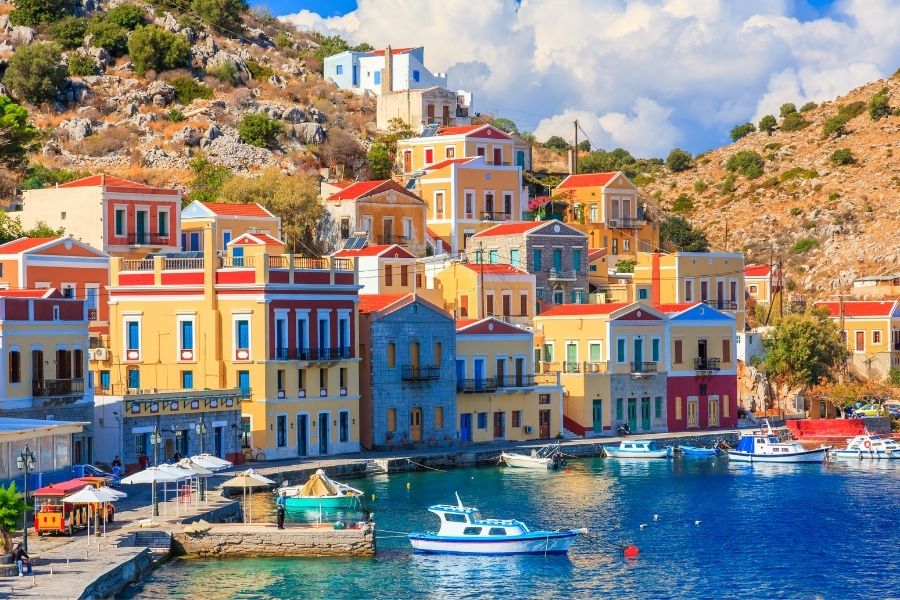
Patmos attracts spiritual travelers to the Cave of the Apocalypse. Besides its religious history, it’s got some stunning beaches.
You can also head to Leros for Art Deco architecture or Halki if you want a quiet day on the sand. Ferry schedules change by season, so I always check ahead before heading out.
Active Adventures: Cycling, Water Sports, and Sailing
Kos makes outdoor adventures easy, no matter the time of year. The flat landscape and coastal roads are a dream for cyclists.
Bike rental shops pop up all over Kos Town. You’ll find everything from mountain bikes to electric ones. The coastal ride to Lambi Beach is a favorite, but if you’re up for a challenge, try the climb to Zia.
Water activities available:
- Windsurfing at Mastichari
- Scuba diving among ancient underwater ruins
- Stand-up paddleboarding in calm bays
- Kayaking along the island’s coastline
Sailing trips leave from Kos harbor every day. You’ll visit secluded beaches and nearby islands, with most boats offering snorkeling gear and a Greek lunch.
Major beaches like Tigaki and Kardamena have water sports centers. Beginners can rent equipment and sign up for lessons if you’re feeling adventurous.
Flavors of the Island: Kos Cuisine, Local Taverns, and Dining Experiences
Kos serves up fantastic Greek food and some unique island dishes like pitaridia pasta. From waterfront tavernas in Mastichari to hidden spots in the mountains, there’s no shortage of places to eat. Local wine and honey make perfect partners for all that seafood.
Traditional Greek Cuisine: Moussaka, Dolmades, and Tzatziki
I’ve tasted moussaka all over Greece, but the version in Kos stands out—layers of eggplant, hearty meat sauce, and creamy béchamel, often baked in wood-fired ovens.
Dolmades here come stuffed with rice, herbs, and sometimes a little meat. The best ones, in my opinion, are from family-run spots where recipes pass down through generations.
Tzatziki appears with almost every meal. It’s thick Greek yogurt, cucumber, garlic, and a drizzle of local olive oil—simple, but so good with grilled meats.
Kos also serves unique island dishes:
- Pitaridia pasta with caramelized onions and local cheese
- Kanelada—fried dough with honey and cinnamon
- Fresh seafood, cooked the old-fashioned way

You can really taste the island’s Italian influences and the freshness of local ingredients in these dishes.
Best Places for Local Dining
Kos Town Center has the widest range. Platanos Restaurant sits beneath an ancient plane tree and serves up Greek classics. Mavromatis has been around since the ‘60s, and their family recipes shine.
Mastichari Harbor is the place for seafood. Makis Taverna gets its fish straight from the morning boats—can’t get fresher than that.
Mountain villages like Zia and Pyli are perfect for sunset meals. The tavernas here focus on oven-baked specialties and local wines.
| Location | Best For | Price Range |
|---|---|---|
| Kos Town | Traditional Greek | €15-25 per person |
| Mastichari | Fresh seafood | €20-30 per person |
| Mountain villages | Sunset dining | €18-28 per person |
Wine, Olives, and Sweet Delicacies by the Sea
Kos produces some surprisingly good wines, thanks to its volcanic soil. Assyrtiko goes great with seafood, and Mandilaria is a solid choice with meat. Wineries often host tastings with killer views.
The local olive oil packs a peppery punch—must be something about the volcanic ground. I picked up a few bottles at the Tuesday market in Kos Town.
Thyme honey is another highlight. Bees collect nectar from wild thyme on the slopes, and the result is rich, fragrant honey. It’s perfect on local yogurt.

For sweets, you can’t miss bougatsa from a bakery in the morning or loukoumades (those addictive honey puffs) at a seaside café. Pair them with strong Greek coffee as the sun sets.
Frequently Asked Questions
Kos mixes ancient healing centers, volcanic hot springs, and gorgeous beaches into a travel experience you won’t soon forget. The island’s history, from Hippocrates to the present, blends with natural thermal waters and plenty of activities for families.
What are the top attractions to visit in Kos for a historical experience?
The Asklepion stands out as the top historical site on Kos. Dedicated to Asclepius, the god of medicine, this ancient sanctuary once drew people from all over.
I suggest visiting the spot where Hippocrates is said to have taught. The ruins also offer sweeping views over the Aegean.
The Ancient Agora in Kos Town lets you walk through history right in the heart of the city. It’s easy to imagine ancient life as you wander.
You’ll also want to see the Hippocrates Tree. Locals say it’s over 2,400 years old, and it’s a favorite photo stop near the castle.
Can you recommend family-friendly activities in Kos for families?
Cycling around Kos Town is a blast for families with older kids. Flat paths and safe routes make it easy.
Rent bikes and head to the Pine Forest of Kos. Shaded trails work for all ages.
Agios Stefanos Beach offers calm, shallow water—ideal for little swimmers. It’s a relaxed spot for a family day.
The Archaeological Museum of Kos keeps kids interested with hands-on exhibits about ancient Greek culture.
What unique experiences should travelers seek out in Kos?
Take a day trip to Nisyros Island for something different. The short ferry ride brings you to an active volcanic crater you can actually walk around.
Explore the volcano and the village of Mandraki for a change of pace and scenery. The views are out of this world.
If you’re up for a hike, Mount Dikeos rewards you with panoramic views from the highest point on the island.
Visiting Zia village gives you a taste of mountain life and traditional Greek hospitality. The drive or bike ride up winds through beautiful countryside.
How can visitors make the most of a single day on the island of Kos?
Kick off your morning by exploring Kos Town’s main historical spots. The Ancient Agora and Hippocrates Tree are close together and easy to check out.
Spend your afternoon at a nearby beach—Agios Stefanos is close and convenient.
Wrap up the day with dinner at a taverna by the harbor. Order local favorites like seafood or moussaka and watch the sunset.
Sticking to the town center helps you avoid wasting time in transit. That way, you get a taste of both history and beach life in just one day.
Where can one find the best hot springs and natural spas in Kos?
Head to Embros Therme for natural hot springs right on the beach. Hot mineral water mixes with the sea, making for a unique soak.
Go during cooler months if you can—the contrast between hot water and cool air feels amazing. The springs usually stay around 40-50°C no matter the season.
On Nisyros, volcanic activity creates more natural hot springs and mud baths. It’s a different kind of spa day.
Some Kos hotels offer spa treatments with local thermal water. If you prefer comfort and a bit of luxury, these are worth a try.
What are the must-visit beaches for a relaxing day on Kos?
Agios Stefanos Beach has these crystal-clear waters and soft sand that just beg you to kick off your shoes. You’ll spot sunbed rentals scattered along the shore, and a couple of beachside tavernas make grabbing a cold drink way too easy.
What I love most? The water stays calm, so even if you’re not exactly an Olympic swimmer, you’ll feel right at home. If you hang around until evening, the west-facing beach treats you to some of the best sunsets on the island.
Paradise Beach really does live up to its name—honestly, I almost didn’t want to leave. The sand’s clean, the water’s a dreamy blue, and for some reason, it’s usually less crowded than the beaches closer to Kos Town.
Tigaki Beach goes on for what feels like forever, lined with fine white sand. Families love it here since the water stays shallow and the waves barely make a fuss.

